Principles of Professional Practice in Financial Services Industry
VerifiedAdded on 2022/10/03
|10
|1437
|442
Homework Assignment
AI Summary
This assignment solution addresses key aspects of the financial services industry, including its main sectors (banking, investment, insurance, and tax/accounting) and their interrelationships. It explores the external forces impacting the industry, such as economic, legal, and technological factors, and discusses the impact of events like Brexit. The solution details the Reserve Bank of Australia's role in controlling the Australian economy through interest rate manipulation, along with current exchange rates and their implications for tourists and exporters. It also covers the functions of ASIC, credit activities, and relevant legislation like the National Consumer Credit Protection Act. Furthermore, the assignment provides information on professional development, ethical considerations, and sustainability within the financial sector, including topics such as Triple Bottom Line (TBL) and corporate social responsibility.
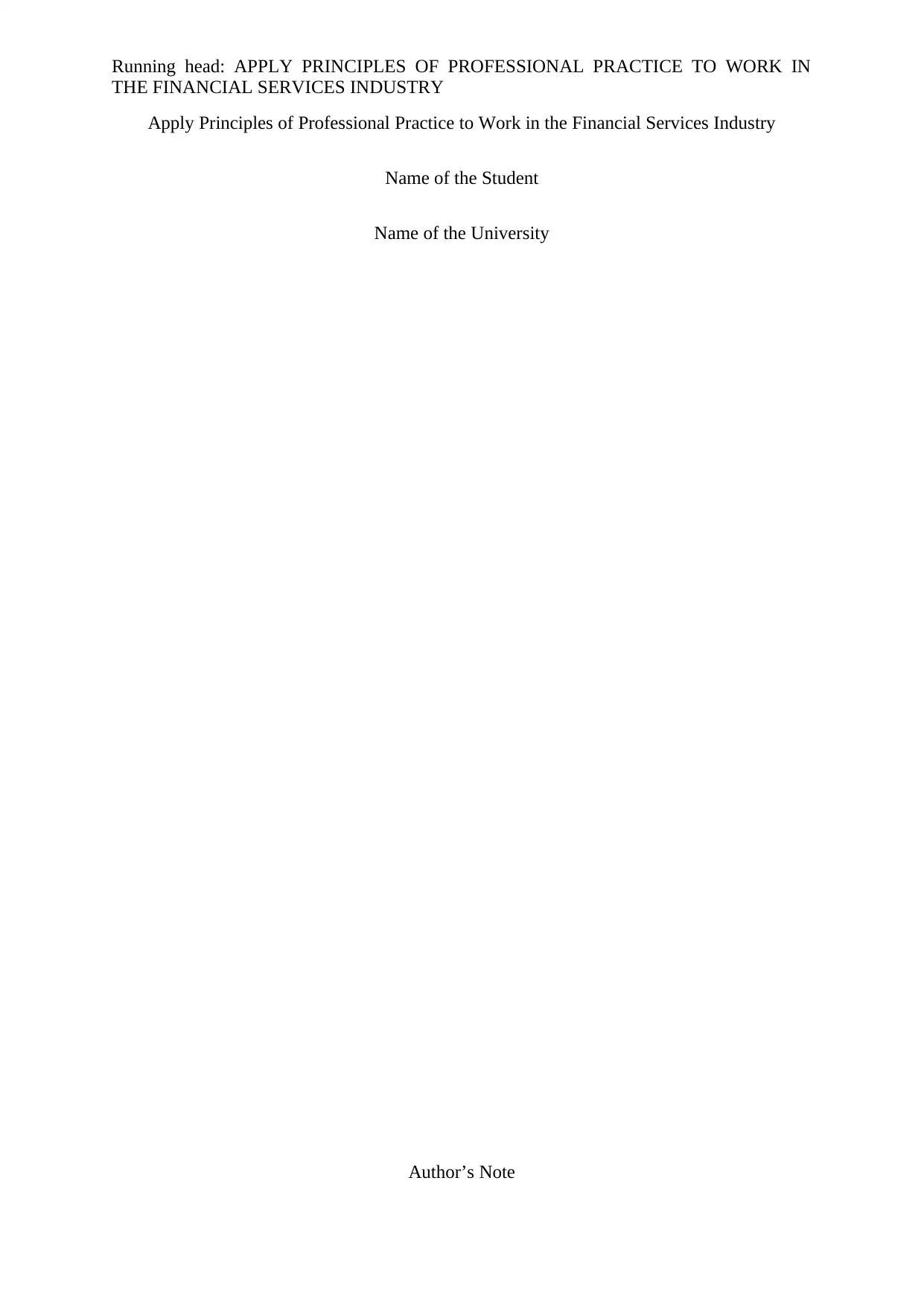
Running head: APPLY PRINCIPLES OF PROFESSIONAL PRACTICE TO WORK IN
THE FINANCIAL SERVICES INDUSTRY
Apply Principles of Professional Practice to Work in the Financial Services Industry
Name of the Student
Name of the University
Author’s Note
THE FINANCIAL SERVICES INDUSTRY
Apply Principles of Professional Practice to Work in the Financial Services Industry
Name of the Student
Name of the University
Author’s Note
Paraphrase This Document
Need a fresh take? Get an instant paraphrase of this document with our AI Paraphraser

1
APPLY PRINCIPLES OF PROFESSIONAL PRACTICE TO WORK IN THE FINANCIAL
SERVICES INDUSTRY
Table of Contents
Question 1..................................................................................................................................4
Question 2..................................................................................................................................4
Question 3..................................................................................................................................4
Question 4..................................................................................................................................4
Question 5..................................................................................................................................4
Question 6..................................................................................................................................5
Question 7..................................................................................................................................5
Question 8..................................................................................................................................5
Question 9..................................................................................................................................6
Question 10................................................................................................................................6
Question 11................................................................................................................................6
Question 12................................................................................................................................6
Question 13................................................................................................................................7
Question 14................................................................................................................................7
Question 15................................................................................................................................7
Question 16................................................................................................................................7
Question 17................................................................................................................................8
Question 18................................................................................................................................9
Question 19................................................................................................................................9
Question 20................................................................................................................................9
Question 21................................................................................................................................9
APPLY PRINCIPLES OF PROFESSIONAL PRACTICE TO WORK IN THE FINANCIAL
SERVICES INDUSTRY
Table of Contents
Question 1..................................................................................................................................4
Question 2..................................................................................................................................4
Question 3..................................................................................................................................4
Question 4..................................................................................................................................4
Question 5..................................................................................................................................4
Question 6..................................................................................................................................5
Question 7..................................................................................................................................5
Question 8..................................................................................................................................5
Question 9..................................................................................................................................6
Question 10................................................................................................................................6
Question 11................................................................................................................................6
Question 12................................................................................................................................6
Question 13................................................................................................................................7
Question 14................................................................................................................................7
Question 15................................................................................................................................7
Question 16................................................................................................................................7
Question 17................................................................................................................................8
Question 18................................................................................................................................9
Question 19................................................................................................................................9
Question 20................................................................................................................................9
Question 21................................................................................................................................9

2
APPLY PRINCIPLES OF PROFESSIONAL PRACTICE TO WORK IN THE FINANCIAL
SERVICES INDUSTRY
Question 22..............................................................................................................................10
Question 23..............................................................................................................................10
Question 24..............................................................................................................................10
Question 25..............................................................................................................................10
APPLY PRINCIPLES OF PROFESSIONAL PRACTICE TO WORK IN THE FINANCIAL
SERVICES INDUSTRY
Question 22..............................................................................................................................10
Question 23..............................................................................................................................10
Question 24..............................................................................................................................10
Question 25..............................................................................................................................10
⊘ This is a preview!⊘
Do you want full access?
Subscribe today to unlock all pages.

Trusted by 1+ million students worldwide
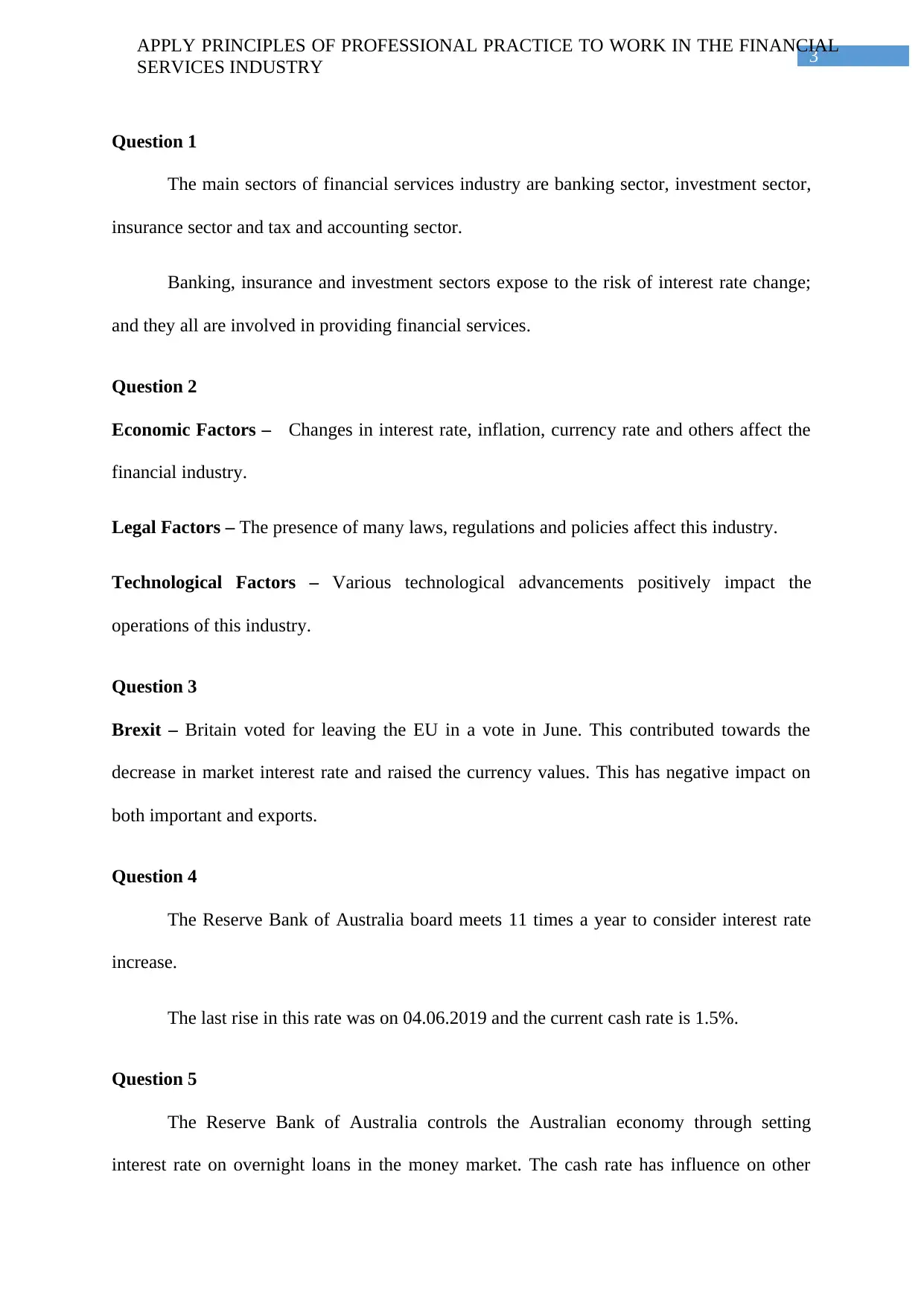
3
APPLY PRINCIPLES OF PROFESSIONAL PRACTICE TO WORK IN THE FINANCIAL
SERVICES INDUSTRY
Question 1
The main sectors of financial services industry are banking sector, investment sector,
insurance sector and tax and accounting sector.
Banking, insurance and investment sectors expose to the risk of interest rate change;
and they all are involved in providing financial services.
Question 2
Economic Factors – Changes in interest rate, inflation, currency rate and others affect the
financial industry.
Legal Factors – The presence of many laws, regulations and policies affect this industry.
Technological Factors – Various technological advancements positively impact the
operations of this industry.
Question 3
Brexit – Britain voted for leaving the EU in a vote in June. This contributed towards the
decrease in market interest rate and raised the currency values. This has negative impact on
both important and exports.
Question 4
The Reserve Bank of Australia board meets 11 times a year to consider interest rate
increase.
The last rise in this rate was on 04.06.2019 and the current cash rate is 1.5%.
Question 5
The Reserve Bank of Australia controls the Australian economy through setting
interest rate on overnight loans in the money market. The cash rate has influence on other
APPLY PRINCIPLES OF PROFESSIONAL PRACTICE TO WORK IN THE FINANCIAL
SERVICES INDUSTRY
Question 1
The main sectors of financial services industry are banking sector, investment sector,
insurance sector and tax and accounting sector.
Banking, insurance and investment sectors expose to the risk of interest rate change;
and they all are involved in providing financial services.
Question 2
Economic Factors – Changes in interest rate, inflation, currency rate and others affect the
financial industry.
Legal Factors – The presence of many laws, regulations and policies affect this industry.
Technological Factors – Various technological advancements positively impact the
operations of this industry.
Question 3
Brexit – Britain voted for leaving the EU in a vote in June. This contributed towards the
decrease in market interest rate and raised the currency values. This has negative impact on
both important and exports.
Question 4
The Reserve Bank of Australia board meets 11 times a year to consider interest rate
increase.
The last rise in this rate was on 04.06.2019 and the current cash rate is 1.5%.
Question 5
The Reserve Bank of Australia controls the Australian economy through setting
interest rate on overnight loans in the money market. The cash rate has influence on other
Paraphrase This Document
Need a fresh take? Get an instant paraphrase of this document with our AI Paraphraser

4
APPLY PRINCIPLES OF PROFESSIONAL PRACTICE TO WORK IN THE FINANCIAL
SERVICES INDUSTRY
interest rates in the economy that affects the behaviour of lenders and borrowers, economic
activity and inflation rate.
Question 6
The current exchange rates are as follows:
The US Dollar –1.47 AUD
The UK Pound –1.77 AUD
The Japanese Yen – 0.014 AUD
The European Euro –1.67
a. 33.94 USD, 28.2 UK Pound, 3,586.40 Japanese Yen and 30.00 European Euro.
b. It will be beneficial for the Australian tourists due to price fluctuation since this will
increase the value of currency while the wine exporters will have to pay increased
price.
Question 7
ASIC is responsible for enforcing and regulating company and financial service laws.
ASIC is responsible for administrating the legislations like Corporations Act 2001
(Cth), Insurance Contracts Act, 1984 and National Consumer Credit Protection Act
(2009).
Question 8
The types of businesses are authorised deposit-taking institutions, general insurance,
Life insurance and friendly societies, private health insurance and superannuation.
APPLY PRINCIPLES OF PROFESSIONAL PRACTICE TO WORK IN THE FINANCIAL
SERVICES INDUSTRY
interest rates in the economy that affects the behaviour of lenders and borrowers, economic
activity and inflation rate.
Question 6
The current exchange rates are as follows:
The US Dollar –1.47 AUD
The UK Pound –1.77 AUD
The Japanese Yen – 0.014 AUD
The European Euro –1.67
a. 33.94 USD, 28.2 UK Pound, 3,586.40 Japanese Yen and 30.00 European Euro.
b. It will be beneficial for the Australian tourists due to price fluctuation since this will
increase the value of currency while the wine exporters will have to pay increased
price.
Question 7
ASIC is responsible for enforcing and regulating company and financial service laws.
ASIC is responsible for administrating the legislations like Corporations Act 2001
(Cth), Insurance Contracts Act, 1984 and National Consumer Credit Protection Act
(2009).
Question 8
The types of businesses are authorised deposit-taking institutions, general insurance,
Life insurance and friendly societies, private health insurance and superannuation.
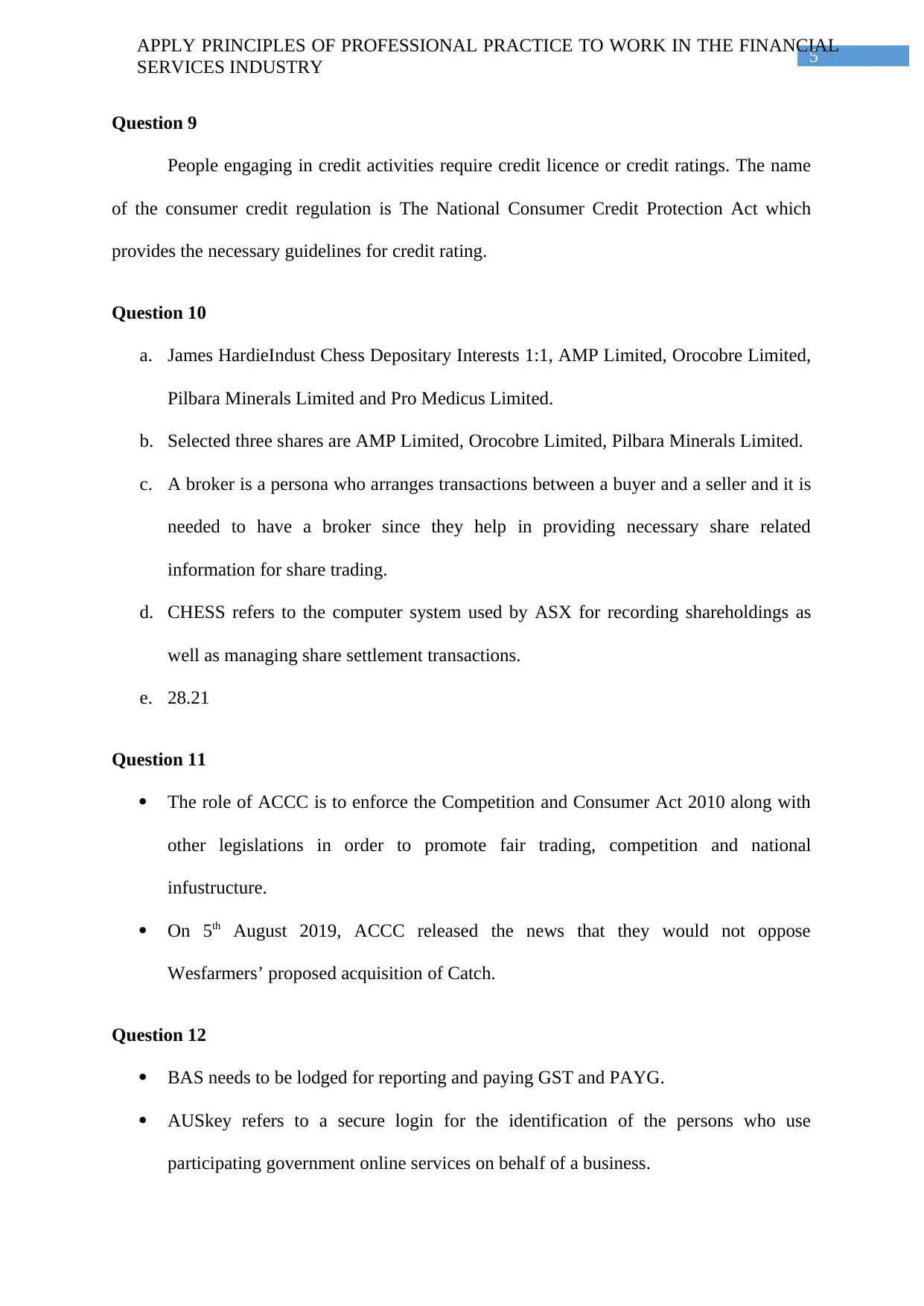
5
APPLY PRINCIPLES OF PROFESSIONAL PRACTICE TO WORK IN THE FINANCIAL
SERVICES INDUSTRY
Question 9
People engaging in credit activities require credit licence or credit ratings. The name
of the consumer credit regulation is The National Consumer Credit Protection Act which
provides the necessary guidelines for credit rating.
Question 10
a. James HardieIndust Chess Depositary Interests 1:1, AMP Limited, Orocobre Limited,
Pilbara Minerals Limited and Pro Medicus Limited.
b. Selected three shares are AMP Limited, Orocobre Limited, Pilbara Minerals Limited.
c. A broker is a persona who arranges transactions between a buyer and a seller and it is
needed to have a broker since they help in providing necessary share related
information for share trading.
d. CHESS refers to the computer system used by ASX for recording shareholdings as
well as managing share settlement transactions.
e. 28.21
Question 11
The role of ACCC is to enforce the Competition and Consumer Act 2010 along with
other legislations in order to promote fair trading, competition and national
infustructure.
On 5th August 2019, ACCC released the news that they would not oppose
Wesfarmers’ proposed acquisition of Catch.
Question 12
BAS needs to be lodged for reporting and paying GST and PAYG.
AUSkey refers to a secure login for the identification of the persons who use
participating government online services on behalf of a business.
APPLY PRINCIPLES OF PROFESSIONAL PRACTICE TO WORK IN THE FINANCIAL
SERVICES INDUSTRY
Question 9
People engaging in credit activities require credit licence or credit ratings. The name
of the consumer credit regulation is The National Consumer Credit Protection Act which
provides the necessary guidelines for credit rating.
Question 10
a. James HardieIndust Chess Depositary Interests 1:1, AMP Limited, Orocobre Limited,
Pilbara Minerals Limited and Pro Medicus Limited.
b. Selected three shares are AMP Limited, Orocobre Limited, Pilbara Minerals Limited.
c. A broker is a persona who arranges transactions between a buyer and a seller and it is
needed to have a broker since they help in providing necessary share related
information for share trading.
d. CHESS refers to the computer system used by ASX for recording shareholdings as
well as managing share settlement transactions.
e. 28.21
Question 11
The role of ACCC is to enforce the Competition and Consumer Act 2010 along with
other legislations in order to promote fair trading, competition and national
infustructure.
On 5th August 2019, ACCC released the news that they would not oppose
Wesfarmers’ proposed acquisition of Catch.
Question 12
BAS needs to be lodged for reporting and paying GST and PAYG.
AUSkey refers to a secure login for the identification of the persons who use
participating government online services on behalf of a business.
⊘ This is a preview!⊘
Do you want full access?
Subscribe today to unlock all pages.

Trusted by 1+ million students worldwide

6
APPLY PRINCIPLES OF PROFESSIONAL PRACTICE TO WORK IN THE FINANCIAL
SERVICES INDUSTRY
ECI is used for transmitting large amount of data to the ATO.
Chris Jordan.
CGT Concession and small businesses are eligible for this when the turnover
threshold is $2 million.
5 years.
4 years.
Question 13
As per the Anti-Money Laundering & Counter-Terrorism Financing Act 2006, the
obligation of the reporting entities is to report the suspicious matters to AUSTRAC (5). In
addition, a reporting entity is needed to submit an SMR in case it forms a rational doubt in
money laundering, financing for terrorism and other crimes like tax evasion and fraud.
Question 14
The Information Commission issues the tax file number under section 17 of the
Privacy Act; and this regulates the collection, use, storage, security, disclosure and disposal
of the information on the tax file number of the individuals.
Question 15
It is important because that the accountants be competent in the profession. Three
ways to maintain professional development are on the job training and learning, participation
in new projects and peruse doctoral studies.
Question 16
a. Office of Consumer and Business Affairs for registration as a licenced conveyancer in
South Australia.
APPLY PRINCIPLES OF PROFESSIONAL PRACTICE TO WORK IN THE FINANCIAL
SERVICES INDUSTRY
ECI is used for transmitting large amount of data to the ATO.
Chris Jordan.
CGT Concession and small businesses are eligible for this when the turnover
threshold is $2 million.
5 years.
4 years.
Question 13
As per the Anti-Money Laundering & Counter-Terrorism Financing Act 2006, the
obligation of the reporting entities is to report the suspicious matters to AUSTRAC (5). In
addition, a reporting entity is needed to submit an SMR in case it forms a rational doubt in
money laundering, financing for terrorism and other crimes like tax evasion and fraud.
Question 14
The Information Commission issues the tax file number under section 17 of the
Privacy Act; and this regulates the collection, use, storage, security, disclosure and disposal
of the information on the tax file number of the individuals.
Question 15
It is important because that the accountants be competent in the profession. Three
ways to maintain professional development are on the job training and learning, participation
in new projects and peruse doctoral studies.
Question 16
a. Office of Consumer and Business Affairs for registration as a licenced conveyancer in
South Australia.
Paraphrase This Document
Need a fresh take? Get an instant paraphrase of this document with our AI Paraphraser
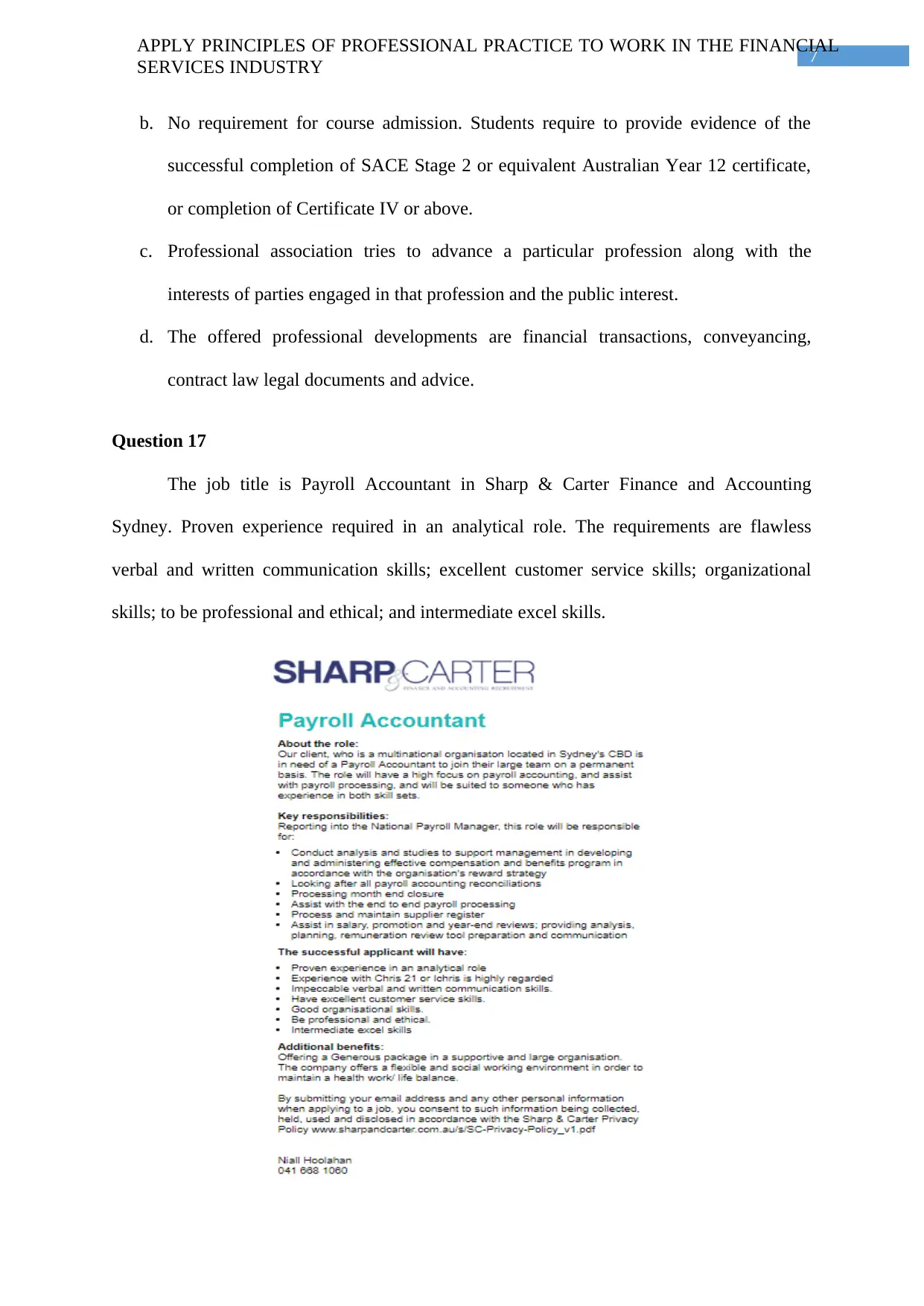
7
APPLY PRINCIPLES OF PROFESSIONAL PRACTICE TO WORK IN THE FINANCIAL
SERVICES INDUSTRY
b. No requirement for course admission. Students require to provide evidence of the
successful completion of SACE Stage 2 or equivalent Australian Year 12 certificate,
or completion of Certificate IV or above.
c. Professional association tries to advance a particular profession along with the
interests of parties engaged in that profession and the public interest.
d. The offered professional developments are financial transactions, conveyancing,
contract law legal documents and advice.
Question 17
The job title is Payroll Accountant in Sharp & Carter Finance and Accounting
Sydney. Proven experience required in an analytical role. The requirements are flawless
verbal and written communication skills; excellent customer service skills; organizational
skills; to be professional and ethical; and intermediate excel skills.
APPLY PRINCIPLES OF PROFESSIONAL PRACTICE TO WORK IN THE FINANCIAL
SERVICES INDUSTRY
b. No requirement for course admission. Students require to provide evidence of the
successful completion of SACE Stage 2 or equivalent Australian Year 12 certificate,
or completion of Certificate IV or above.
c. Professional association tries to advance a particular profession along with the
interests of parties engaged in that profession and the public interest.
d. The offered professional developments are financial transactions, conveyancing,
contract law legal documents and advice.
Question 17
The job title is Payroll Accountant in Sharp & Carter Finance and Accounting
Sydney. Proven experience required in an analytical role. The requirements are flawless
verbal and written communication skills; excellent customer service skills; organizational
skills; to be professional and ethical; and intermediate excel skills.
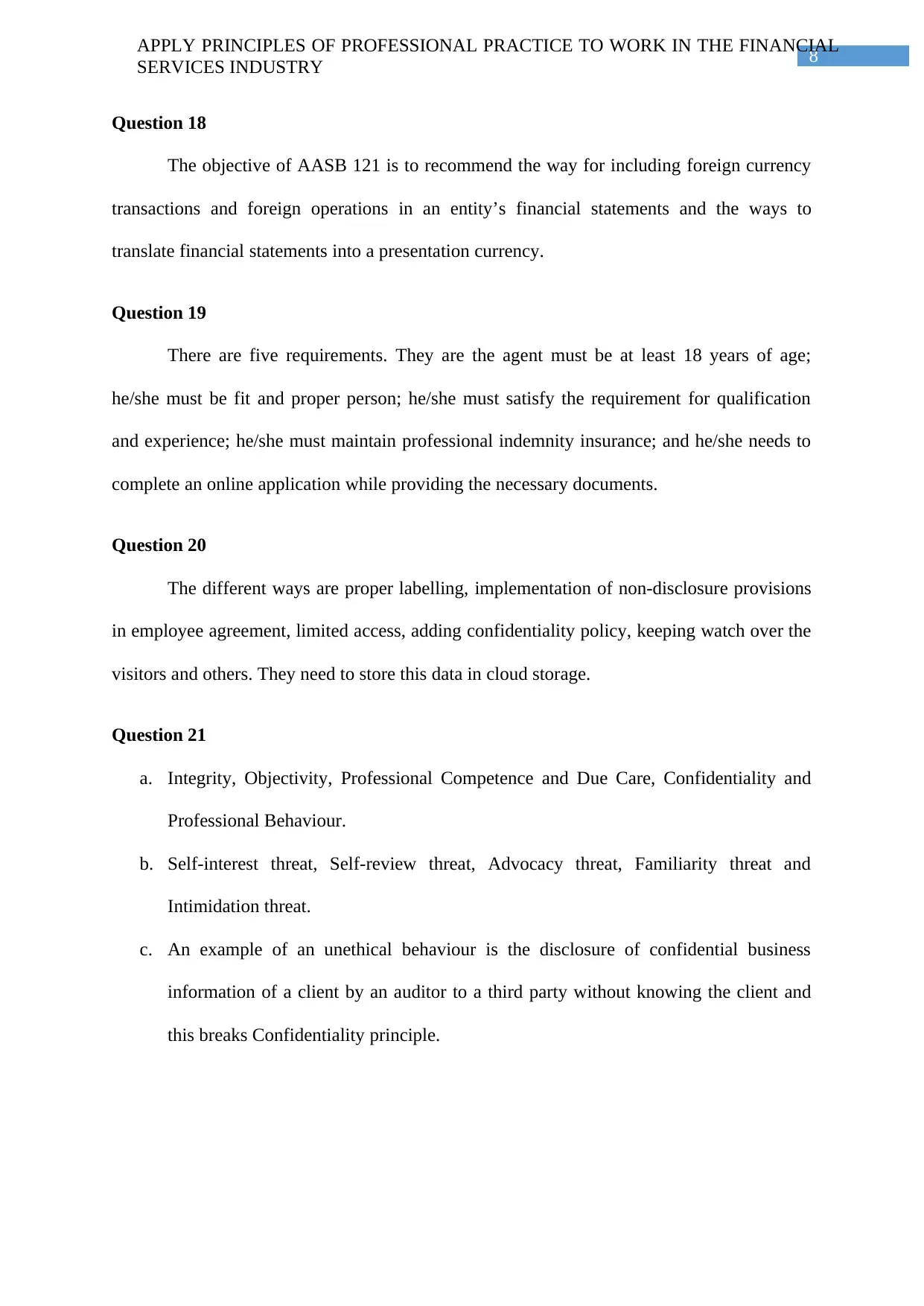
8
APPLY PRINCIPLES OF PROFESSIONAL PRACTICE TO WORK IN THE FINANCIAL
SERVICES INDUSTRY
Question 18
The objective of AASB 121 is to recommend the way for including foreign currency
transactions and foreign operations in an entity’s financial statements and the ways to
translate financial statements into a presentation currency.
Question 19
There are five requirements. They are the agent must be at least 18 years of age;
he/she must be fit and proper person; he/she must satisfy the requirement for qualification
and experience; he/she must maintain professional indemnity insurance; and he/she needs to
complete an online application while providing the necessary documents.
Question 20
The different ways are proper labelling, implementation of non-disclosure provisions
in employee agreement, limited access, adding confidentiality policy, keeping watch over the
visitors and others. They need to store this data in cloud storage.
Question 21
a. Integrity, Objectivity, Professional Competence and Due Care, Confidentiality and
Professional Behaviour.
b. Self-interest threat, Self-review threat, Advocacy threat, Familiarity threat and
Intimidation threat.
c. An example of an unethical behaviour is the disclosure of confidential business
information of a client by an auditor to a third party without knowing the client and
this breaks Confidentiality principle.
APPLY PRINCIPLES OF PROFESSIONAL PRACTICE TO WORK IN THE FINANCIAL
SERVICES INDUSTRY
Question 18
The objective of AASB 121 is to recommend the way for including foreign currency
transactions and foreign operations in an entity’s financial statements and the ways to
translate financial statements into a presentation currency.
Question 19
There are five requirements. They are the agent must be at least 18 years of age;
he/she must be fit and proper person; he/she must satisfy the requirement for qualification
and experience; he/she must maintain professional indemnity insurance; and he/she needs to
complete an online application while providing the necessary documents.
Question 20
The different ways are proper labelling, implementation of non-disclosure provisions
in employee agreement, limited access, adding confidentiality policy, keeping watch over the
visitors and others. They need to store this data in cloud storage.
Question 21
a. Integrity, Objectivity, Professional Competence and Due Care, Confidentiality and
Professional Behaviour.
b. Self-interest threat, Self-review threat, Advocacy threat, Familiarity threat and
Intimidation threat.
c. An example of an unethical behaviour is the disclosure of confidential business
information of a client by an auditor to a third party without knowing the client and
this breaks Confidentiality principle.
⊘ This is a preview!⊘
Do you want full access?
Subscribe today to unlock all pages.

Trusted by 1+ million students worldwide

9
APPLY PRINCIPLES OF PROFESSIONAL PRACTICE TO WORK IN THE FINANCIAL
SERVICES INDUSTRY
Question 22
Sustainability refers to manage as well as coordinate environmental, financial and
social demands and concerns for ensuring responsible, ethical and ongoing success of a
business.
Question 23
Triple Bottom Line (TBL) is a framework that recommends the companies to focus
on social and environmental issues through considering three aspects which are Profit, People
and Planet.
For example, 3M collaborates with United Way for funding STEM education all over
the world which is a great example of enlightened self-interest.
Question 24
Business organizations can include the impact of their business operations on the
environment and can take initiative to reduce these effects.
Question 25
GRI – This focuses on corporate social responsibilities with an equal focus on
environmental, social and governance issues.
CDP – This focuses on GHG emission while addressing the issues like water and forestry.
GRESB – It focuses on environmental, social and governance issues in the global
commercial and real estate sector.
APPLY PRINCIPLES OF PROFESSIONAL PRACTICE TO WORK IN THE FINANCIAL
SERVICES INDUSTRY
Question 22
Sustainability refers to manage as well as coordinate environmental, financial and
social demands and concerns for ensuring responsible, ethical and ongoing success of a
business.
Question 23
Triple Bottom Line (TBL) is a framework that recommends the companies to focus
on social and environmental issues through considering three aspects which are Profit, People
and Planet.
For example, 3M collaborates with United Way for funding STEM education all over
the world which is a great example of enlightened self-interest.
Question 24
Business organizations can include the impact of their business operations on the
environment and can take initiative to reduce these effects.
Question 25
GRI – This focuses on corporate social responsibilities with an equal focus on
environmental, social and governance issues.
CDP – This focuses on GHG emission while addressing the issues like water and forestry.
GRESB – It focuses on environmental, social and governance issues in the global
commercial and real estate sector.
1 out of 10
Related Documents
Your All-in-One AI-Powered Toolkit for Academic Success.
+13062052269
info@desklib.com
Available 24*7 on WhatsApp / Email
![[object Object]](/_next/static/media/star-bottom.7253800d.svg)
Unlock your academic potential
Copyright © 2020–2025 A2Z Services. All Rights Reserved. Developed and managed by ZUCOL.




